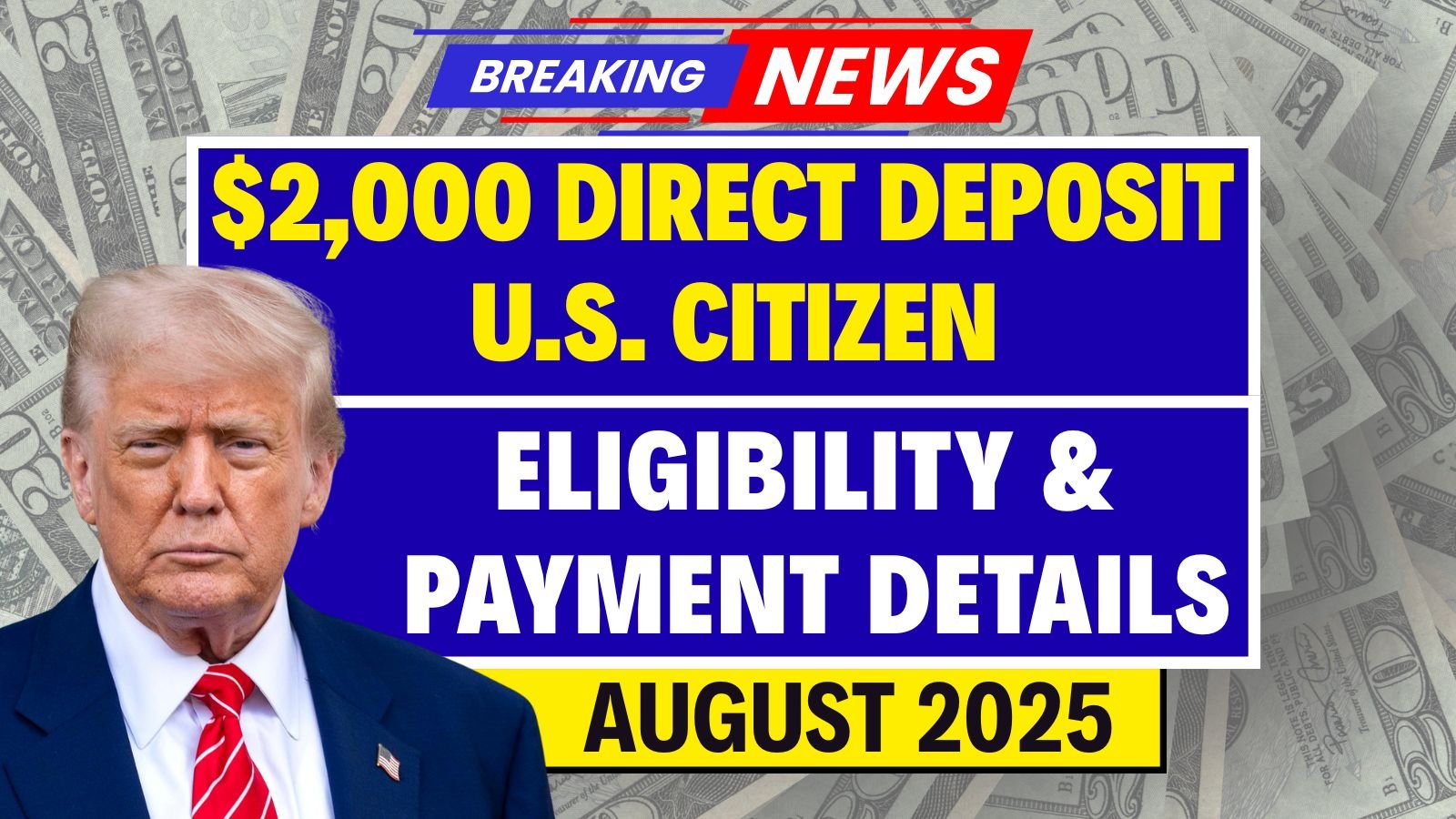The announcement of a $2,000 Direct Deposit has sparked conversations across households in the United States. At a time when inflation, rising housing costs, and day-to-day expenses continue to weigh heavily on American families, this payment is expected to provide much-needed financial relief. For millions of citizens, especially those relying on Social Security, disability, or veterans’ benefits, the direct deposit will act as a lifeline. But how exactly will this payment work? Who qualifies, when will it arrive, and why is it being issued? Let’s break it all down in detail.
Understanding the $2,000 Direct Deposit
This payment is not officially being called the “fourth stimulus check,” though many are treating it as such. Instead, the $2,000 Direct Deposit is part of a broader financial relief measure connected to tax credit reforms. Its purpose is to provide quick, accessible assistance to families and individuals still struggling with the economic aftershocks of the pandemic, the rising cost of living, and global economic instability. The government aims to ensure that the funds directly reach those who need them most without requiring complex applications or waiting periods.
The payment will be handled in much the same way as previous relief initiatives — through direct deposits, mailed checks, or prepaid debit cards.
Eligibility Criteria for the $2,000 Direct Deposit
Not everyone will qualify for this financial assistance. The eligibility rules are clear and based largely on income thresholds, tax filings, and residency requirements. Here’s what you need to know:
You are eligible if:
- You filed taxes for 2023 or 2024 (whichever was most recent).
- Your adjusted gross income (AGI) is within the following limits:
- Under $75,000 for individuals
- Under $150,000 for married couples filing jointly
- Under $112,500 for heads of household
- You receive Social Security, Supplemental Security Income (SSI), Veterans benefits, or Disability benefits and have a valid mailing or banking address.
You are not eligible if:
- Your income exceeds the thresholds mentioned above.
- You do not have a Social Security Number or legal U.S. residency.
- You were claimed as a dependent on someone else’s tax return (for example, many college students under the age of 24).
These requirements are consistent with past stimulus-style payments, making the $2,000 Direct Deposit easier to implement without confusion.
How Will the Payment Be Distributed?
The government wants this payment to reach people quickly and securely. To achieve that, the $2,000 Direct Deposit will primarily be distributed electronically. Here’s how it will work:
- Direct Bank Deposit: If you have already provided your bank details to the IRS through tax filings, or if your information is current with the Social Security Administration (SSA) or Veterans Affairs (VA), the payment will go directly into your bank account.
- Paper Checks: For individuals who have not provided direct deposit details, a physical check will be mailed to the most recent address on file.
- Prepaid Debit Cards: In certain cases, individuals may receive their $2,000 Direct Deposit funds on a prepaid debit card mailed to them, similar to previous relief efforts.
The method of payment depends on the government’s records for your account and address.
Timeline for the $2,000 Direct Deposit
The government has officially announced that payments will begin rolling out on August 15, 2025, with the entire distribution expected to be completed by August 30, 2025.
- Direct Deposits: These will typically arrive first, often within the first week of processing. For many, the money will appear in their bank accounts within days of the rollout starting.
- Paper Checks: Checks take longer to process and deliver. Depending on postal service efficiency, these may arrive a week or two later than direct deposits.
- Prepaid Debit Cards: Cards will also take some time to print, process, and ship. Expect delays compared to direct deposits.
For most recipients, the fastest way to get the $2,000 Direct Deposit is to ensure their banking information is current with the IRS or SSA.
Do You Need to Apply?
One of the best parts about this program is that no separate application is required. As long as you meet the eligibility requirements, the payment will be processed automatically.
However, there are a few important exceptions:
- If you haven’t filed taxes for 2023 or 2024, you may need to do so as soon as possible to ensure your eligibility is confirmed.
- If your banking details have changed recently, you must update your information on the IRS portal or through the SSA website to avoid delays.
- For people who qualify based on Social Security, SSI, SSDI, or VA benefits, the payment should still arrive even without a recent tax return, as long as your information is up to date.
Why the $2,000 Direct Deposit Matters
In today’s economic climate, $2,000 can make a significant difference. For many families, this amount could mean catching up on overdue rent, paying off a utility bill, buying groceries, or managing transportation costs. For seniors and those on fixed incomes, the $2,000 Direct Deposit is more than just money — it’s a symbol of stability and reassurance.
The rising cost of living has left many households struggling to stretch their paychecks. Groceries, gas, and rent have all seen substantial increases, and wages haven’t always kept up. This payment is designed to bridge that gap temporarily, offering some breathing room while policymakers continue to work on long-term solutions.
The emotional impact of this relief shouldn’t be overlooked either. Beyond paying bills, it represents hope, compassion, and recognition of the struggles ordinary citizens face. The $2,000 Direct Deposit is about restoring some peace of mind in uncertain times.
Frequently Asked Questions (FAQs)
Q1. Is this the fourth stimulus check?
Not officially. While many are comparing it to past stimulus payments, the $2,000 Direct Deposit is a financial relief measure tied to tax credit reforms, not a new stimulus package.
Q2. Will everyone get $2,000?
No. Only those who meet the income, residency, and filing requirements will receive the full $2,000. Payments may also be reduced for individuals who are close to the income threshold.
Q3. I didn’t file taxes. Can I still qualify?
Possibly. If you receive Social Security, SSI, SSDI, or VA benefits, and your information is current in government systems, you may still receive the payment. However, it’s highly recommended to file a simple tax return to avoid issues.
Q4. What if my bank account changed?
If your direct deposit information has changed since your last tax filing, update it immediately through the IRS portal or SSA website. Otherwise, your payment may be delayed, or you may receive a paper check instead.
Q5. Are the payments taxable?
The $2,000 Direct Deposit is not considered taxable income, similar to previous relief payments. You do not have to pay taxes on this amount.
Q6. What if I moved recently?
If you’ve moved, make sure your mailing address is updated with the IRS or SSA. Otherwise, checks or debit cards could be delayed or sent to the wrong address.
Final Thoughts
The $2,000 Direct Deposit is more than just a one-time payment. It represents a commitment by the government to support citizens in challenging times. While it won’t solve every financial struggle, it provides immediate relief that can cover essentials and ease financial anxiety for millions.
For those who qualify, the key steps are simple: ensure your tax filings are up to date, verify your banking or mailing information, and stay informed about the payment timeline. By doing so, you can make sure your $2,000 Direct Deposit arrives without unnecessary delays.
As families wait for the payments to begin in mid-August 2025, the sense of anticipation is high. For many, this deposit could not come at a better time — bringing not only financial assistance but also a sense of relief and stability when it’s needed most.
Some Important Link
| Download News APP | Click Here |
| WhatsApp Group | Click Here |
| Home Page | Click Here |





